One of the biggest reasons the Atlanta Falcons improved from an 8-8 season in 2015 to the Super Bowl is offensive coordinator Kyle Shanahan's ability to mesh his creative playbook with the high-level talent on the roster.
The Falcons led the league in scoring during the regular season (33.8 points per game) and put up a combined 80 points in their two playoff wins over the Seattle Seahawks and Green Bay Packers.
Let's break down Shanahan's go-to plays: 15 concepts you can look for on Sunday, when the Falcons face the New England Patriots in Super Bowl LI.
Cross-Country Dagger
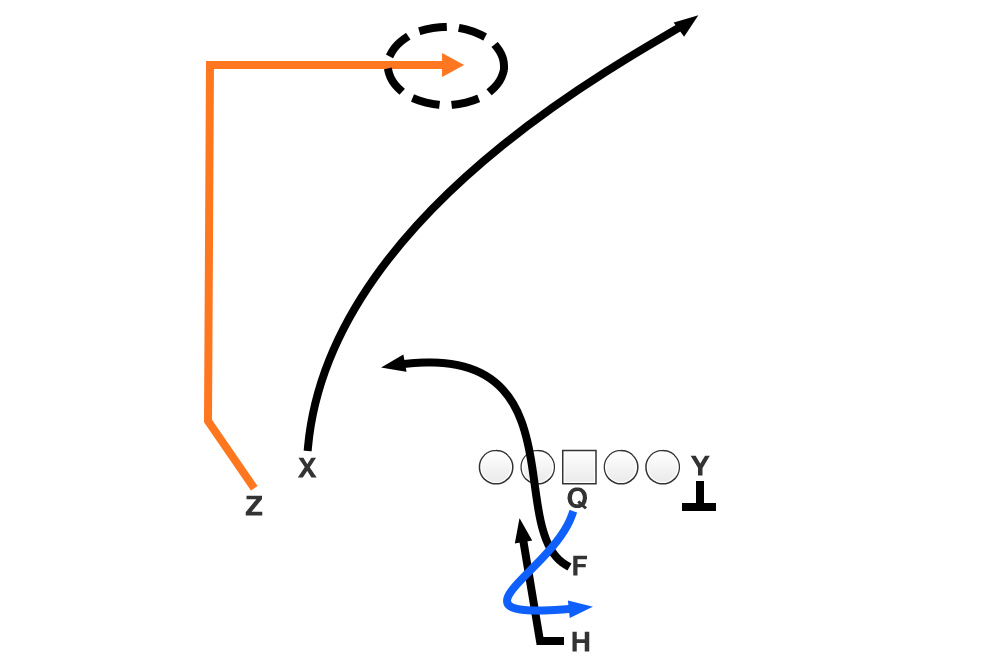
The Falcons led the NFL in multiple categories when running play-action during the regular season, such as passes thrown (133), yards per attempt (11.8) and total passing yards (1,531).
That's what we see here on the cross-country dagger out of a standard pro I slot formation with wide receivers Julio Jones (Z) and Mohamed Sanu (X) stacked outside. This is a deep clear-out concept, with quarterback Matt Ryan (Q) using the weakside play-action to running back Devonta Freeman (H) to bring the second-level defenders to the line of scrimmage.
That opens up an inside throwing window to hit Jones on the 15-yard dig-route (square-in) while Sanu bends the seam to run off the top of the secondary. It's a high-percentage throw for Ryan (inside breaking route) with Jones working to the vacated area of the field.
Outside Zone
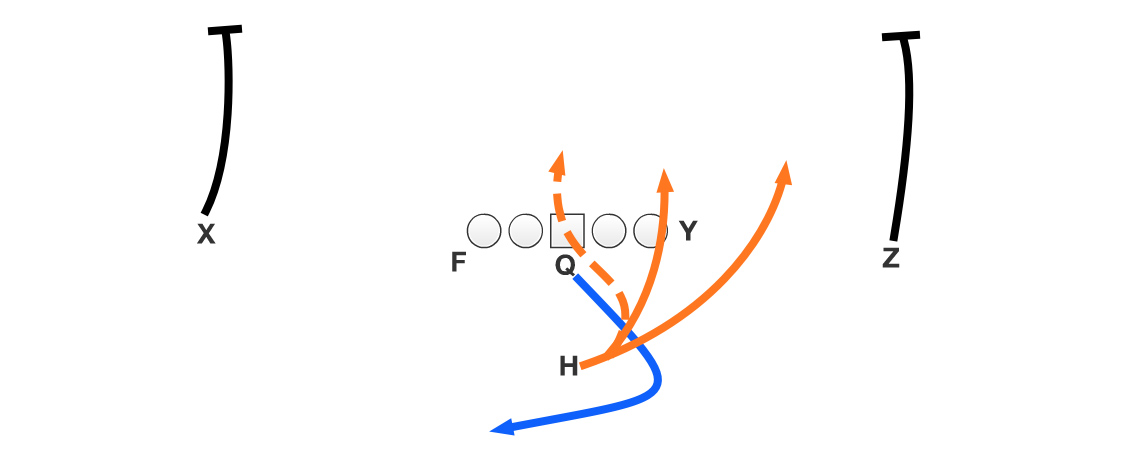
The Falcons ranked fifth overall during the regular season with 120.5 rushing yards per game, and the outside zone (or stretch) is one of the top calls in Shanahan's playbook. It caters to the athleticism of the Falcons' offensive line and the skill set of both Freeman and Tevin Coleman (footwork, vision, speed through the hole).
With the offensive line taking a "zone step" (step to play side) and chipping to the second-level linebackers, the running backs have options after getting the handoff deep in the backfield. Freeman or Coleman (H) can "bounce" the ball outside of the tight end (Y), hit the "bang" or cut the ball back on the "bend." It's up to the RB to make the correct read based on the blocking up front and the pursuit of the linebackers. This is another reason the vision of the Falcons' running backs is so critical. See the field. Make one cut. And go.
Boot

Working off the outside zone scheme look, Shanahan will lean on the boot concept. This allows Ryan to set the bait for the linebackers with a play-action fake before rolling away from the initial play side on the boot action.
The idea is to take advantage of poor defensive eye discipline (failure to read run-pass keys) while giving Ryan (and his underrated mobility) a two-level read and clean throwing windows outside of the pocket. Sanu (Z) runs the deep out (or comeback), Taylor Gabriel (W) works back on the crossing route and tight end Austin Hooper (Y) releases late to the flat. Ryan's initial read is to the front side of the formation off the play-action, as Jones (X) likely will occupy two defenders downfield on the post.
Look for this boot scheme on Sunday, when the Falcons have the ball in the "strike zone" (Patriots' 20-35-yard line) or the red zone.
Levels

The Falcons love to use levels concepts. These can be packaged into hi-lo reads for Ryan while also creating natural "pick" situations for wide receivers and backs to come clean as underneath options.
Here, the Falcons align in an empty set with Freeman (H) removed from the formation. This gives Ryan a "levels" concept to the strong side of the formation with Hooper (Y) running the dig route and both Gabriel (Z) and Jones (W) on the smash routes (5-yard in-cuts). This creates a natural pick for Jones on the inside cut to beat man coverage on a middle-of-the-field throw.
To the weakside, Ryan can throw the "VO" concept (vertical-out) with Sanu (X) on the fade and Freeman running the flat route. But Ryan's first read is to the three-WR side of the formation -- and he can throw this concept versus both zone and man coverage. Get the ball out and give your receivers room to run after the catch. That's free money.
Follow Route

Shanahan is a master at using bunch and stacked looks to create traffic off the snap versus man-coverage teams. And the abilities of Freeman and Coleman as receiving threats add to Shanahan's game plan.
With Sanu (Z) and Hooper (Y) in reduced splits, and Freeman (H) aligned on the outside leg of the offensive tackle, the Falcons create a bunch formation (three players close together). This allows Hooper to release upfield on the corner route to generate a mess of bodies as Sanu runs the shallow crosser and Freeman hits the angle route.
Freeman beat the Seahawks for a big gain in the divisional round with this concept and scored a TD against the Packers in the red zone. Tough to defend.
Power O

The Falcons are a zone-based running team, but that doesn't mean Shanahan won't reduce the formation to run power schemes out of two-TE personnel (Y and U).
This is the Power O, an old-school concept with the tight end (Y) blocking down on the edge, the fullback, Patrick DiMarco (F), leading to kick out the edge defender, and left guard Andy Levitre pulling through the hole.
This creates a lane for Freeman or Coleman (H) to run inside the kickout block and follow the guard to the second level. Look for this when the Falcons are inside the plus 5-yard line or in short-yardage situations. And remember, in the Power O, there is nowhere to hide. Hat on a hat. Put on the big-boy pads and play downhill football.
Yankee Route

The Yankee route traces back to Shanahan's time in Washington with Robert Griffin III at quarterback. It's a deep play-action concept designed to create an open throwing lane by occupying the top of the defense. Throw in some added window dressing, and this is a tough concept to defend.
The Falcons align the wide receivers in reduced splits tight to the core of the formation (false run keys) and use the run action to remove the underneath defenders. At the snap, the tight end (Y) comes back across the formation on the arc block, with Freeman (H) on the downhill zone action and Gabriel on the reverse (W). This allows Ryan (Q) to go through two play-action fakes while Jones (X) runs the deep post. That removes the backside cornerback and occupies the safety in the deep middle of the field.
With Sanu (Z) working back on the deep crossing route, Ryan can set his feet off the play-action and target the receiver in the now-vacated area of the field. This is a classic "shot zone" play for Shanahan (ball between the 40s), creating an opportunity for the Falcons to flip the field or advance into scoring position.
RPO Slant
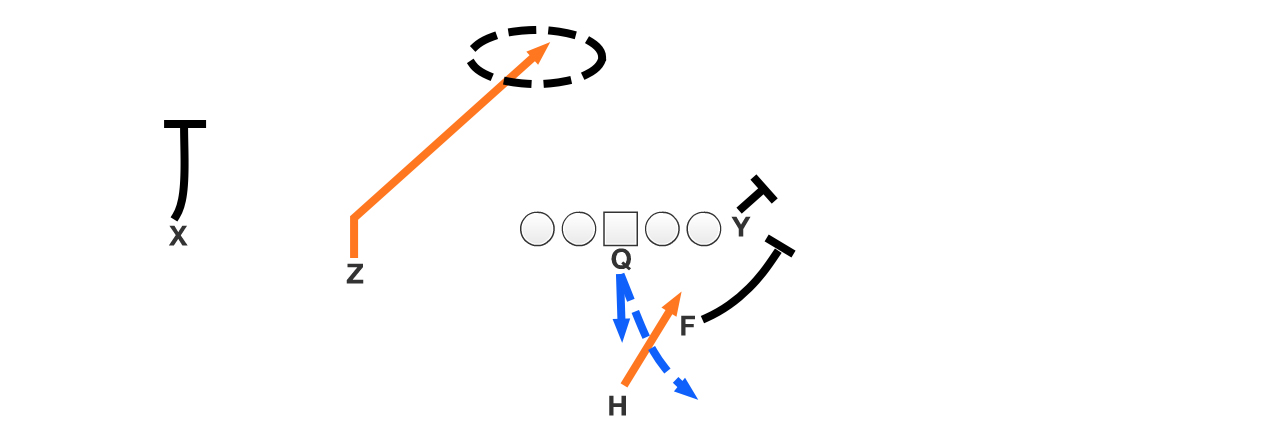
Run-pass options (RPOs) have taken over at the lower levels of the game (high school and college), and we are seeing them more and more in the pros. This is a run concept paired with a passing play that should make the offense right every time, assuming the QB makes the correct pre-snap read.
In Atlanta, Shanahan pairs the two-back zone scheme with the backside slant. This allows Ryan to count the number of defenders in the box and read the leverage/alignment of the defensive back versus the slot receiver.
Ryan can hand the ball off to Freeman or Coleman (H) in the zone scheme, with DiMarco (F) leading on the edge, if the Falcons have the numbers advantage in the box. Ryan can also immediately throw the quick one-step slant to Sanu (Z) if the QB likes the matchup (and defensive look) in the passing game.
Four Verticals
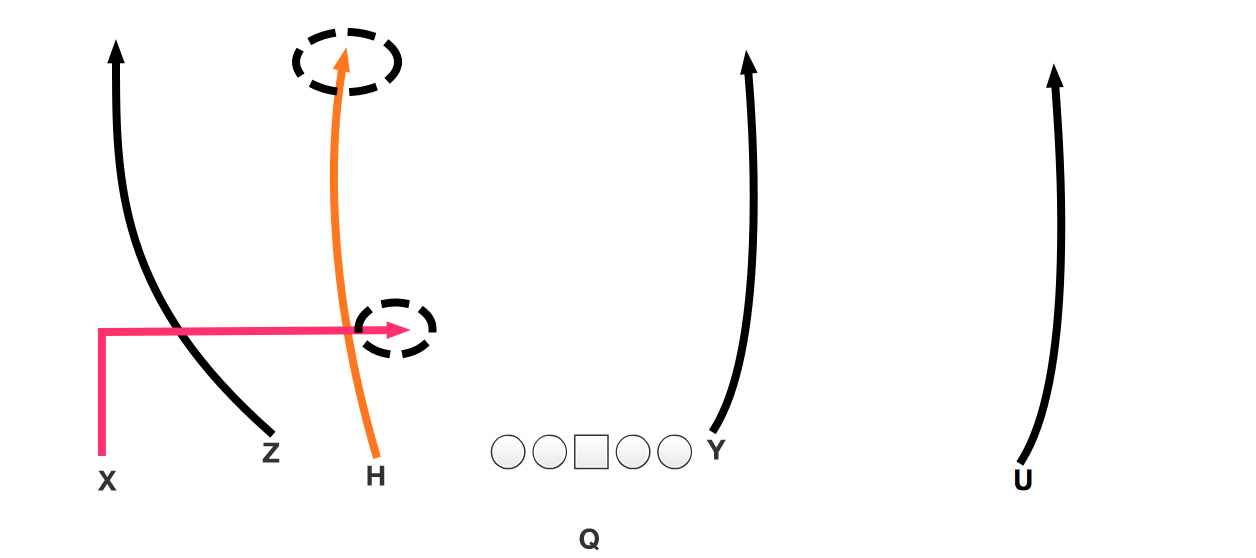
The four vertical concept is run throughout the league, but Shanahan does a really good job of dressing it up based on personnel and alignment with an added bonus of an underneath option.
With two tight ends and two wide receivers on the field, the Falcons shift Coleman (H) from the backfield out wide. This can create matchup issues for man-coverage teams (linebacker has to remove in coverage) with Coleman pressing downfield on the inside seam. That gives the Falcons four vertical routes, with Coleman and Hooper (Y) running the seam routes and Sanu (Z) and Levine Toilolo (U) on the outside fades.
However, don't forget about Jones (X) running the inside smash or shallow crosser. This allows Ryan to use Jones as a checkdown or underneath matchup option. And getting the ball to Jones with space to run after the catch is a nightmare for opposing defenses.
Hi-Lo Mesh

The "mesh" concept is a common route seen on Saturdays in the college game with spread teams, but it's also a top call for Shanahan due to the hi-lo combination and the option to hit Freeman or Coleman on the quick wheel (or rail) route.
With two tight ends and two receivers in the game, aligned in a double-stack look, the Falcons can create pick situations at the release with Toilolo (U) running the corner route and Jones (X) coming on the shallow crosser. That gives Ryan a two-level read inside with Jones underneath (low) and Hooper (Y) on the dig (high).
The key, however, is the release and route of the running back (H). This forces the linebacker in coverage to work through the releases and crossing routes to match the back. That's trouble for the defense when Ryan can get the ball out. Get stuck behind the back, and it could mean six on the board for the Falcons.
Inside Zone
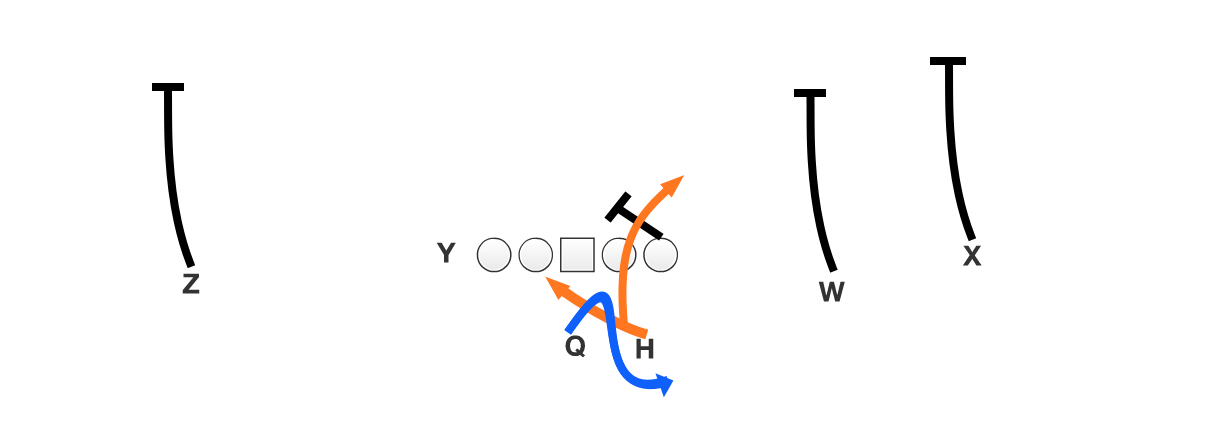
Along with the "duo" scheme (straight downhill run with double-teams at the point of attack), the Falcons will show the inside zone. With the offensive line again taking the "zone step" and Ryan aligned in the shotgun, the running back can find daylight on an inside run off the mesh-point action (quarterback-running back exchange).
However, the key to the Falcons' inside zone goes back to the ability of Freeman and Coleman (H). With the end man on the line of scrimmage left unblocked, the running back can "bend" the ball back in the natural cutback lane that is created off the mesh point, hugging the block of the right tackle in this example.
Keep an eye on this scheme when the Falcons get inside the plus 5-yard line. And expect Coleman to get the ball. He hits the line like a rocket. Target the quick cutback and get the ball into the end zone for six before the end man can close to the ball.
Z-Iso
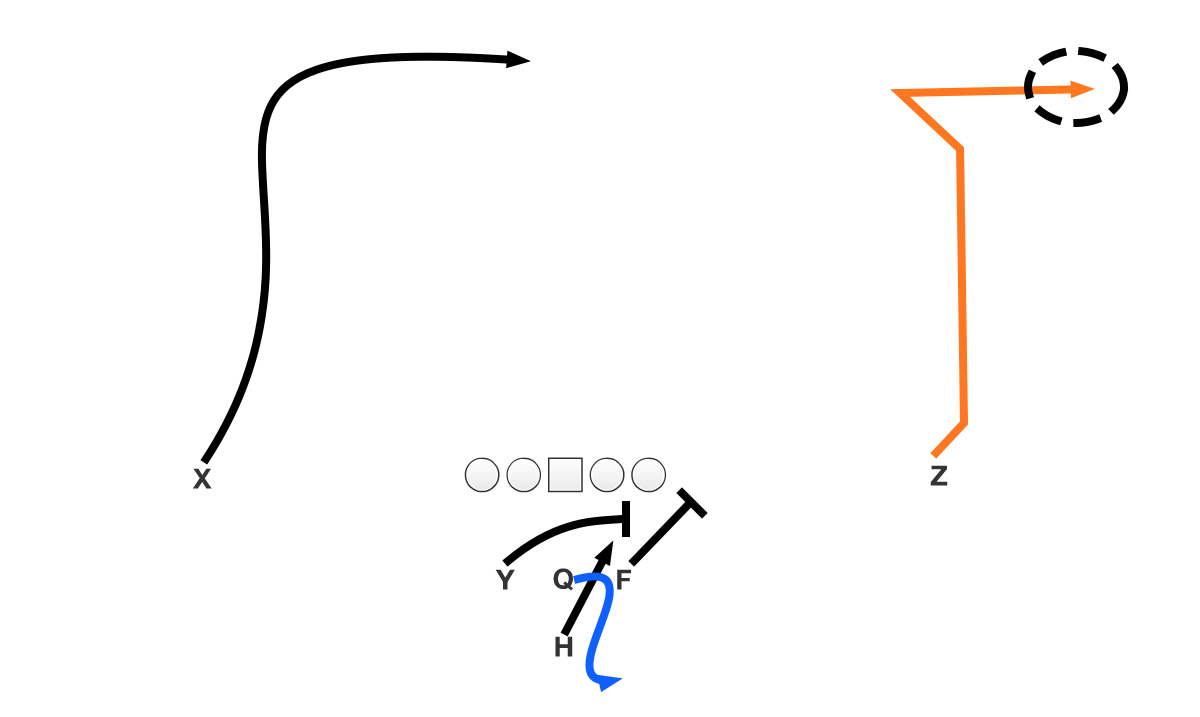
The Falcons will run the standard three-step concepts (slant-flat, curl-flat, stick-outs, etc.) as the rest of NFL offenses do, but I like Shanahan's ability to use deep routes off play-action to target Jones with max protection.
Again, Shanahan dresses up this route with a diamond or inverted bone look (three backs in the backfield) and Ryan in the pistol alignment. That puts Hooper (Y) and DiMarco (F) in offset alignments, with Freeman (H) behind the quarterback. This allows the Falcons to use play-action while also giving Ryan added protection off the fake as this route takes some time to develop.
In reality, this is nothing more than an isolation route for Jones (Z) with Gabriel (X) running the backside dig. At the snap, Jones releases up the field and stems inside to sell the deep dig or post look. This forces the cornerback to overplay the break while Jones works back on the deep out route. It's a long throw for Ryan (outside of the numbers), but with the extra time to set his feet, Ryan can rip this ball to Jones.
This is a great call versus two-man coverage as the cornerback will be sitting inside and the safety playing top-down. Look for it on Sunday and focus on the backfield set. This is where Shanahan likes to attack the matchup with Jones in a one-on-one situation.
WR Screen

The wide receiver screen is a quick way to get the ball into the hands of Gabriel. He's electric in the open field given his burst and lateral change-of-direction ability. And it's nothing more than a long handoff for Ryan.
With three wide receivers on the field, Sanu (X) and Gabriel (W) align in stack tight to the core of the formation. At the snap, the Falcons use quick play-action to hold the linebackers in the box, with Freeman (H) faking a zone-run look. This allows Sanu to block the force defender outside with both the left tackle and left guard releasing to block the first threats.
After that, it's up to Gabriel. Read the blocks, find daylight and accelerate up the field. This is the same scheme (out of different formations) that Gabriel scored on versus the Arizona Cardinals in the regular season. And it's also a concept Shanahan will use in the deep red zone with Freeman aligned as a receiver. Don't make it complicated here. Just get the ball to your playmakers with blockers out in front on a super high-percentage throw.
Crack Toss
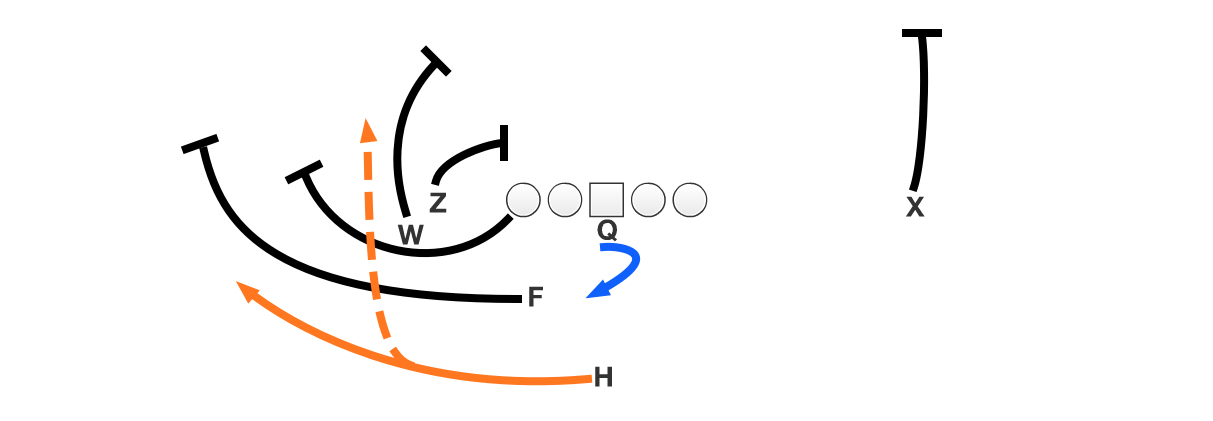
The crack toss is a great call from Shanahan versus man-coverage teams because it forces the defensive backs to become edge players with the big guys leading or pulling outside. And it can be almost automatic in the deep red zone, where hesitation from the defense leads to points.
With two wide receivers again aligned in stack tight to the core of the formation, Sanu (X) blocks down on the edge (called a "crack" block) and Gabriel (W) blocks the first second-level threat. This allows the Falcons to pull left tackle Jake Matthews while DiMarco (F) leads outside. Off the toss, Coleman (H) can press the ball to the edge or cut up the field based on the leverage of the defenders.
The key here: Will the defensive backs assigned to cover Sanu and Gabriel react quickly enough off the blocks (replace on the edge), and are they willing to get downhill to take on both Matthews and DiMarco? If the defensive backs follow the receivers inside or widen versus the blocks, this is a walk-in score -- just as we saw on Coleman's touchdown run in the NFC Championship Game win over the Packers.
TE Throwback
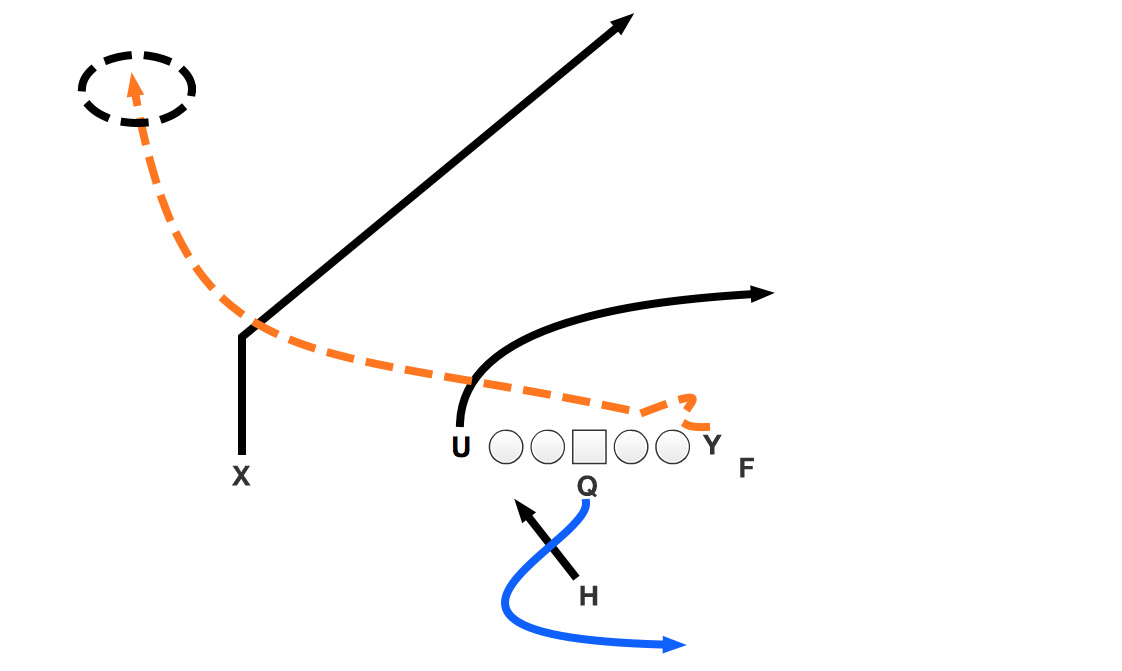
I saved one of Shanahan's top gadget calls for last because this could be a critical play in Super Bowl LI versus the Patriots' heavy man-coverage schemes.
Why does it work? For starters, it combines two of the Falcons' top calls -- outside zone and boot. That's what Shanahan wants to show the defense before sneaking the tight end all the way back across the formation.
At the snap, the Falcons use play-action, with Freeman (H) on the zone look, and Ryan rolls away from the play side (boot). This allows the backside tight end (U) to run the shallow crosser with Jones (X) on the post. The idea is to pull the coverage back to the opposite side of the field while the strongside tight end (Y), either Hooper or Toilolo, blocks before releasing downfield.
Yes, this concept is on tape. And the Patriots are the most prepared team in the NFL from a defensive perspective. You can bet they will run through this gadget concept in practice. But at game speed? With all the window dressing Shanahan throws into the mix? Maybe the Falcons can get a free one Sunday.
Hey, stuff happens. And even the top defenses take the bait from time to time. That's football.
